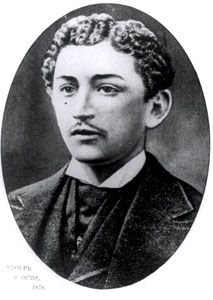
Chattanooga Times
In a lavishly paneled executive board room on the fourteenth floor of the New York Times Building on West Forty-third Street in Manhattan, the home of the nation’s most influential daily newspaper, stands a bust of Adolph S. Ochs, the founder of the modern Times and patriarch of the family that rules it still. It is a gift from the people of Chattanooga, a postbellum city that seems a world away from the busy center of New York. But there is a deep, and important, family connection between the two: the bust was sent north to thank Ochs for constructing a lovely gold-domed building for the Chattanooga Times in that city on the banks of the Tennessee River.
Eighteen years before he moved to Manhattan and bought another financially strapped publication, the New York Times, in 1896, Ochs had acquired the struggling Chattanooga paper. From a financial point of view, the second investment worked out much better, but the Ochs-Sulzberger family has always kept a spot in its heart–and its publishing empire–for the small southern paper, which in fact played a significant role in one of the nation’s most compelling twentieth-century domestic dramas: the Civil Rights movement and the emergence, by fits and starts, of the New South.
Ochs was not the first owner of the paper. The Times had been founded in 1869 by Chattanoogans T. B. Kirby, Frank DeGorgis, and Patten L. Gamble. The three founders bought the used equipment of a failed newspaper, the Chattanooga Republican, but their Times was not a raging success: it passed through several hands, including those of T. H. Payne and Z. C. Patten, before ebbing to two hundred subscribers in 1878, the year Ochs came along. Though not yet twenty-one, he was an energetic businessman and had already put together a city directory–an enterprise that enabled him to make contacts with Chattanooga’s principal businessmen. With two hundred dollars (his father co-signed the note) young Ochs bought the publisher’s title and a half-interest in the paper.
More than just a savvy investor (he quickly became sole owner and improved the paper’s fortunes), Ochs was a key player in the journalistic revolution of the period. Until roughly the 1870s, American newspapers were essentially partisan, house organs for political parties or the whims of the publication’s owner. There was no difference between the news and editorial columns: the entire paper was given over to provocative, necessarily unbalanced reporting. Ochs helped change that, deciding to keep the news columns evenhanded and confining overt political opinion to separate editorial pages. This desire for balance was expressed in his motto: “To give the news impartially, without fear or favor.” In Chattanooga he crusaded for city improvements such as closed sewers (after yellow fever outbreaks), better fire protection (after a big downtown blaze), and bond issues for streets and bridges.
By 1896, however, Ochs found himself in financial trouble not because of the Times but because of his sundry real estate investments. To bail himself out, he determined to make money doing what he knew best: turning around a newspaper. He bought the then-failing New York Times at a sheriff’s auction and moved to Manhattan to rebuild that paper. Though he never returned to the South permanently, he always considered himself a Chattanoogan, retaining the title of publisher of that city’s newspaper until his death during a visit to Chattanooga in 1935.
Four other members of his family then held that title, but one–Ruth Sulzberger Holmberg–was the most significant, serving as publisher from 1964 to 1992, then as chairman, of the Chattanooga Times. In 1992 Paul Neely became the first non-Ochs publisher of the Times since 1878.
Perhaps the Chattanooga paper’s finest hours came in the 1950s and 1960s when it was the informal center of national coverage of the Civil Rights movement that slowly took shape after the Supreme Court’s 1954 school desegregation decision. The key figure in these years was John N. Popham, a Virginian, who was sent south by New York Times managing editor Turner Catledge in 1947 to be the first full-time national correspondent covering the region. Catledge, a Mississippian, sensed that important changes were in the air, and Popham became New York’s man on the scene, traveling sixty thousand miles a year from the Potomac to Eagle’s Pass and all points in between. He was jailed in Jackson, Mississippi, and shot at in Clinton, Tennessee, and he became a mentor to the stream of national reporters who journeyed south to cover milestones like the crisis at Little Rock’s Central High School. Popham would interpret the local customs and ease the outsiders’ way around the hot spots, keeping order on both sides in those tempestuous times. In 1958 Popham left the New York Times to become managing editor of its Chattanooga cousin, serving until 1978. But even though he was off the road, reporters in search of insights about the changing South found their way to Chattanooga and to Popham.
In the ensuing years the Times frequently championed causes that provoked controversy in a city that, though heavily industrial and part of a border state, remains basically conservative. For example, it backed the Civil Rights Acts of the mid-1960s, the original Clean Air Act, and supported a successful lawsuit by black plaintiffs who sued in the late 1980s to replace Chattanooga’s at-large governing board to one divided into districts–a shift that gave African Americans a larger voice in municipal affairs.
The Times continues to enjoy a reputation as a tough, challenging, well-edited newspaper, with superior writing and reporting. In late 1998 it was sold to Walter Hussman Jr., who merged the Times with the other Chattanooga paper he had recently acquired, the Chattanooga Free Press, into the Chattanooga Times and Chattanooga Free Press in January 1999.



